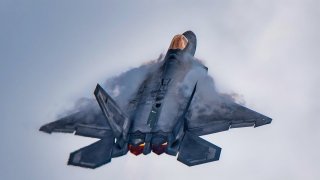F-22 Sea Raptor: Stealth Fighter 'Beast' Flying from U.S. Navy Aircraft Carriers
This incredible stealth, speed, and payload immediately made the Raptor the dominant fighter jet in the skies. Naturally, the Navy considered adapting the F-22 to serve its own needs.
Summary: The Lockheed Martin F-22 Raptor, a cornerstone of U.S. Air Force capabilities, was once considered for adaptation into a carrier-capable variant known as the "Sea Raptor." Despite the F-22's advanced features, including supermaneuverability, stealth, and supercruise capabilities, the Navy variant never materialized.

-Initial plans involved significant design changes to make it suitable for carrier operations, such as incorporating a variable sweep-wing, which would have compromised its stealth. However, the end of the Cold War and subsequent reduced military budget led to the cancellation of extended F-22 production and the shift towards the multirole F-35 platform.
-The Navy then chose the F-35C variant to fulfill its needs for a capable fighter jet equipped with advanced sensors for air combat and reconnaissance missions, marking the end of the Sea Raptor concept.
The F-22 Sea Raptor That Never Was: The Navy's Plan for an Aircraft Carrier-Capable F-22
The Lockheed Martin F-22 Raptor was the first fifth-generation fighter jet to ever fly. The American platform was an instant legend, and it is arguably still a more fearsome aircraft than newer fighter jets. Combining supermaneuverability with stealth and supercruise, the Raptor is a centerpiece of the U.S. Air Force’s aerial strategy.
At one point in time, the Navy desired its own carrier-capable variant. The “Sea Raptor” version, however, never came to fruition.
Introducing the F-22 Raptor
The Raptor was the result of the U.S. Air Force’s Advanced Tactical Fighter program. Designed in the 1980s as an ideal air superiority fighter, the F-22 rectified the service’s perceived “mission deficiency” against the Soviet Union’s growing fleet of modern fighters.

Perhaps the Raptor’s most significant feature is its tiny radar cross-section. In fact, this older platform is at least five times less observable than the F-35 Lightning II. Two Pratt & Whitney F119-PW-100 turbofan engines power the airframe, producing a total thrust of approximately 70,000 pounds. In terms of armament, the jet is equipped with three internal weapons bays. The F-22 in stealth configuration can pack two AIM-9 Sidewinder and six AIM-120 Advanced Medium-Range Air-to-Air Missiles (AMRAAMs) in its side weapons bays, while also carrying two Aim-120 AMRAAM and two GBU-32 JDAM bombs.
F-22 Sea Raptor: What About the Navy’s Carrier-Capable Variant?
This incredible stealth, speed, and payload immediately made the Raptor the dominant fighter jet in the skies. Naturally, the Navy considered adapting the F-22 to serve its own needs. In order to make the jet carrier-capable, Lockheed Martin would have had to incorporate several critical alterations to the platform’s design. The Navy variant would need a variable sweep-wing design similar to the F-14 Tomcat. Since this specific design would sacrifice the stealth aircraft’s small radar cross-section, the endeavor was a challenge for engineers.

Shortly after the Raptor entered the production phase, the collapse of the Soviet Union shifted the playing field for the U.S. military. The usefulness of the F-22 platform was minimized. In fact, production halted at 187 units. The subsequent F-35 Joint Strike Fighter platform was the true multirole aircraft that each service needed. Instead of engineering a carrier-capable variant of the Raptor, the Navy relied on the Lightning IIC variant.
The Navy’s F-35 variant is highly evolved, incorporating advanced sensors that are capable of managing a battle in the air. Additionally, the platform can conduct intelligence, surveillance, and reconnaissance missions. This carrier-capable variant will serve the Navy for decades to come.
About the Author: Maya Carlin
Maya Carlin, National Security Writer with The National Interest, is an analyst with the Center for Security Policy and a former Anna Sobol Levy Fellow at IDC Herzliya in Israel. She has by-lines in many publications, including The National Interest, Jerusalem Post, and Times of Israel. You can follow her on Twitter: @MayaCarlin.
Image Credit: Creative Commons.


